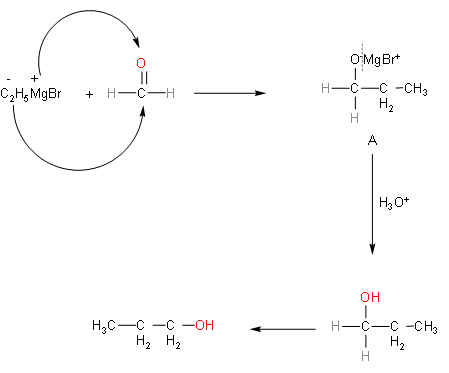Answer
330.2k+ views
Hint: To answer the hydrolysis product, first of all we should find the product from the reaction between formaldehyde and ethyl magnesium bromide and then we will do the hydrolysis of that product.
Complete step by step solution:

So, the above reaction explains the question. We have to find final product B after hydrolysis from A. So, first of all we'll know about Grignard reagent. In this reaction the Grignard reagent that is present is ethyl magnesium bromide. Ethyl magnesium bromide will dissociate into ethyl with negative charge and magnesium bromide with positive charge. In the formaldehyde molecule, oxygen atoms will have negative charge, so magnesium bromide will attack on oxygen part and negative part will get attached to the carbon atom in formaldehyde.

So, from the reaction we can say that A was the intermediate product and was unstable. In the second step, hydrolysis of Product-A gives us propane-1-ol.
So, the correct answer is option C.
Note:We will now know the reason for using magnesium in Grignard reagent. The reaction to the formation of Grignard reagents requires the use of magnesium ribbon. All magnesium is covered with a passivation film of magnesium oxide, which prevents reactions to organic halide. The application of Grignard preformed reagent is also used as an initiator.
We should note that formaldehyde is a colourless, strong-smelling gas used in making building materials and many household products. It is best known for its preservative and anti-bacterial properties.
Complete step by step solution:

So, the above reaction explains the question. We have to find final product B after hydrolysis from A. So, first of all we'll know about Grignard reagent. In this reaction the Grignard reagent that is present is ethyl magnesium bromide. Ethyl magnesium bromide will dissociate into ethyl with negative charge and magnesium bromide with positive charge. In the formaldehyde molecule, oxygen atoms will have negative charge, so magnesium bromide will attack on oxygen part and negative part will get attached to the carbon atom in formaldehyde.

So, from the reaction we can say that A was the intermediate product and was unstable. In the second step, hydrolysis of Product-A gives us propane-1-ol.
So, the correct answer is option C.
Note:We will now know the reason for using magnesium in Grignard reagent. The reaction to the formation of Grignard reagents requires the use of magnesium ribbon. All magnesium is covered with a passivation film of magnesium oxide, which prevents reactions to organic halide. The application of Grignard preformed reagent is also used as an initiator.
We should note that formaldehyde is a colourless, strong-smelling gas used in making building materials and many household products. It is best known for its preservative and anti-bacterial properties.
Recently Updated Pages
If a wire of resistance R is stretched to double of class 12 physics JEE_Main

The path difference between two waves for constructive class 11 physics JEE_MAIN

What is the difference between solvation and hydra class 11 chemistry JEE_Main

IfFxdfrac1x2intlimits4xleft 4t22Ft rightdt then F4-class-12-maths-JEE_Main

Three point particles of mass 1 kg 15 kg and 25 kg class 11 physics JEE_Main

Which of the following explanation is best for not class 12 chemistry JEE_Main

Other Pages
The reaction of Zinc with dilute and concentrated nitric class 12 chemistry JEE_Main

Differentiate between homogeneous and heterogeneous class 12 chemistry JEE_Main

A point charge q placed at the point A is A In stable class 12 physics JEE_Main

Excluding stoppages the speed of a bus is 54 kmph and class 11 maths JEE_Main

P Q and R long parallel straight wires in air carrying class 12 physics JEE_Main

How many grams of concentrated nitric acid solution class 11 chemistry JEE_Main



